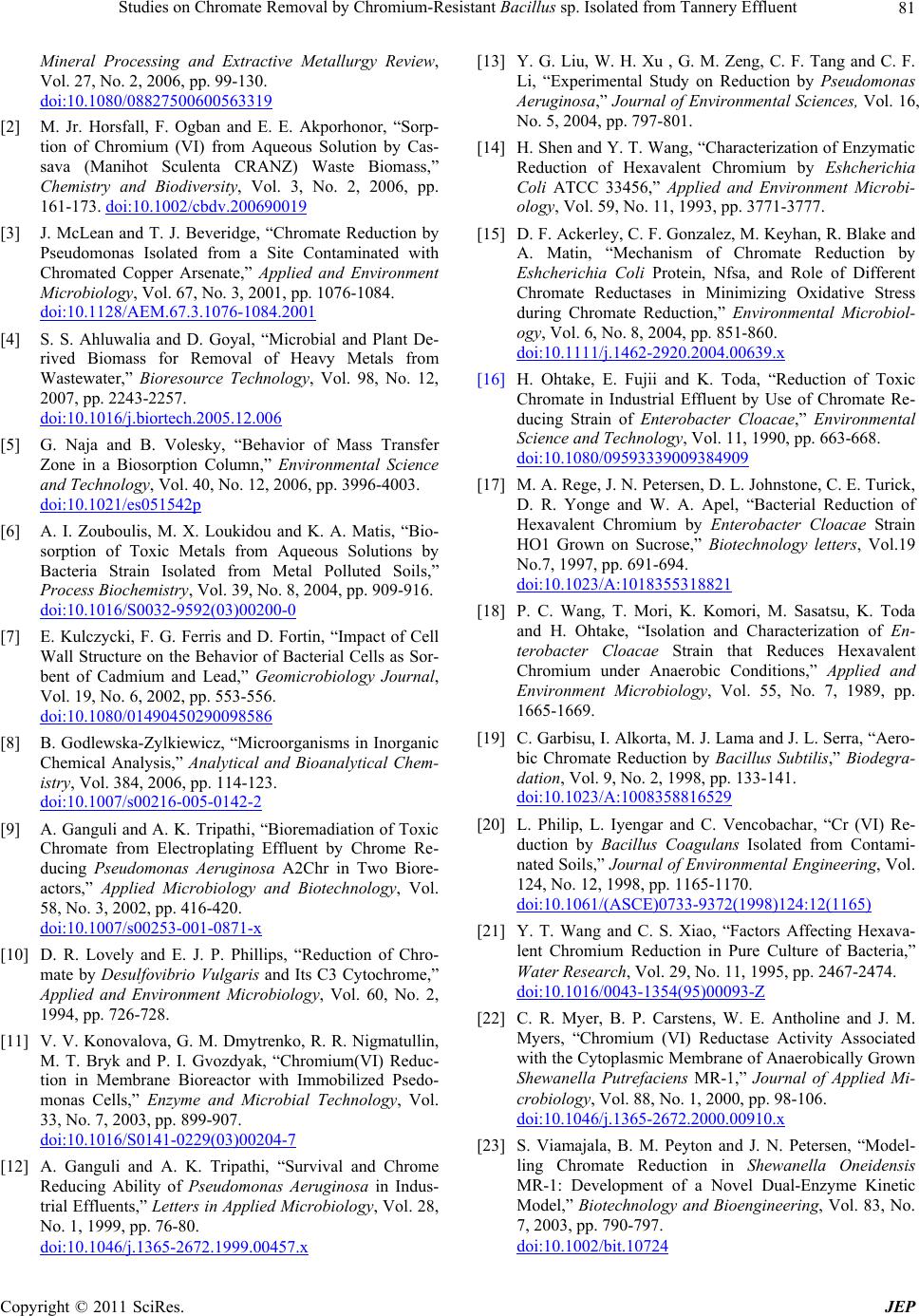
Studies on Chromate Removal by Chromium-Resistant Bacillus sp. Isolated from Tannery Effluent81
Mineral Processing and Extractive Metallurgy Review,
Vol. 27, No. 2, 2006, pp. 99-130.
doi:10.1080/08827500600563319
[2] M. Jr. Horsfall, F. Ogban and E. E. Akporhonor, “Sorp-
tion of Chromium (VI) from Aqueous Solution by Cas-
sava (Manihot Sculenta CRANZ) Waste Biomass,”
Chemistry and Biodiversity, Vol. 3, No. 2, 2006, pp.
161-173. doi:10.1002/cbdv.200690019
[3] J. McLean and T. J. Beveridge, “Chromate Reduction by
Pseudomonas Isolated from a Site Contaminated with
Chromated Copper Arsenate,” Applied and Environment
Microbiology, Vol. 67, No. 3, 2001, pp. 1076-1084.
doi:10.1128/AEM.67.3.1076-1084.2001
[4] S. S. Ahluwalia and D. Goyal, “Microbial and Plant De-
rived Biomass for Removal of Heavy Metals from
Wastewater,” Bioresource Technology, Vol. 98, No. 12,
2007, pp. 2243-2257.
doi:10.1016/j.biortech.2005.12.006
[5] G. Naja and B. Volesky, “Behavior of Mass Transfer
Zone in a Biosorption Column,” Environmental Science
and Technology, Vol. 40, No. 12, 2006, pp. 3996-4003.
doi:10.1021/es051542p
[6] A. I. Zouboulis, M. X. Loukidou and K. A. Matis, “Bio-
sorption of Toxic Metals from Aqueous Solutions by
Bacteria Strain Isolated from Metal Polluted Soils,”
Process Biochemistry, Vol. 39, No. 8, 2004, pp. 909-916.
doi:10.1016/S0032-9592(03)00200-0
[7] E. Kulczycki, F. G. Ferris and D. Fortin, “Impact of Cell
Wall Structure on the Behavior of Bacterial Cells as Sor-
bent of Cadmium and Lead,” Geomicrobiology Journal,
Vol. 19, No. 6, 2002, pp. 553-556.
doi:10.1080/01490450290098586
[8] B. Godlewska-Zylkiewicz, “Microorganisms in Inorganic
Chemical Analysis,” Analytical and Bioanalytical Chem-
istry, Vol. 384, 2006, pp. 114-123.
doi:10.1007/s00216-005-0142-2
[9] A. Ganguli and A. K. Tripathi, “Bioremadiation of Toxic
Chromate from Electroplating Effluent by Chrome Re-
ducing Pseudomonas Aeruginosa A2Chr in Two Biore-
actors,” Applied Microbiology and Biotechnology, Vol.
58, No. 3, 2002, pp. 416-420.
doi:10.1007/s00253-001-0871-x
[10] D. R. Lovely and E. J. P. Phillips, “Reduction of Chro-
mate by Desulfovibrio Vulgaris and Its C3 Cytochrome,”
Applied and Environment Microbiology, Vol. 60, No. 2,
1994, pp. 726-728.
[11] V. V. Konovalova, G. M. Dmytrenko, R. R. Nigmatullin,
M. T. Bryk and P. I. Gvozdyak, “Chromium(VI) Reduc-
tion in Membrane Bioreactor with Immobilized Psedo-
monas Cells,” Enzyme and Microbial Technology, Vol.
33, No. 7, 2003, pp. 899-907.
doi:10.1016/S0141-0229(03)00204-7
[12] A. Ganguli and A. K. Tripathi, “Survival and Chrome
Reducing Ability of Pseudomonas Aeruginosa in Indus-
trial Effluents,” Letters in Applied Microbiology, Vol. 28,
No. 1, 1999, pp. 76-80.
doi:10.1046/j.1365-2672.1999.00457.x
[13] Y. G. Liu, W. H. Xu , G. M. Zeng, C. F. Tang and C. F.
Li, “Experimental Study on Reduction by Pseudomonas
Aeruginosa,” Journal of Environmental Sciences, Vol. 16,
No. 5, 2004, pp. 797-801.
[14] H. Shen and Y. T. Wang, “Characterization of Enzymatic
Reduction of Hexavalent Chromium by Eshcherichia
Coli ATCC 33456,” Applied and Environment Microbi-
ology, Vol. 59, No. 11, 1993, pp. 3771-3777.
[15] D. F. Ackerley, C. F. Gonzalez, M. Keyhan, R. Blake and
A. Matin, “Mechanism of Chromate Reduction by
Eshcherichia Coli Protein, Nfsa, and Role of Different
Chromate Reductases in Minimizing Oxidative Stress
during Chromate Reduction,” Environmental Microbiol-
ogy, Vol. 6, No. 8, 2004, pp. 851-860.
doi:10.1111/j.1462-2920.2004.00639.x
[16] H. Ohtake, E. Fujii and K. Toda, “Reduction of Toxic
Chromate in Industrial Effluent by Use of Chromate Re-
ducing Strain of Enterobacter Cloacae,” Environmental
Science and Technology, Vol. 11, 1990, pp. 663-668.
doi:10.1080/09593339009384909
[17] M. A. Rege, J. N. Petersen, D. L. Johnstone, C. E. Turick,
D. R. Yonge and W. A. Apel, “Bacterial Reduction of
Hexavalent Chromium by Enterobacter Cloacae Strain
HO1 Grown on Sucrose,” Biotechnology letters, Vol.19
No.7, 1997, pp. 691-694.
doi:10.1023/A:1018355318821
[18] P. C. Wang, T. Mori, K. Komori, M. Sasatsu, K. Toda
and H. Ohtake, “Isolation and Characterization of En-
terobacter Cloacae Strain that Reduces Hexavalent
Chromium under Anaerobic Conditions,” Applied and
Environment Microbiology, Vol. 55, No. 7, 1989, pp.
1665-1669.
[19] C. Garbisu, I. Alkorta, M. J. Lama and J. L. Serra, “Aero-
bic Chromate Reduction by Bacillus Subtilis,” Biodegra-
dation, Vol. 9, No. 2, 1998, pp. 133-141.
doi:10.1023/A:1008358816529
[20] L. Philip, L. Iyengar and C. Vencobachar, “Cr (VI) Re-
duction by Bacillus Coagulans Isolated from Contami-
nated Soils,” Journal of Environmental Engineering, Vol.
124, No. 12, 1998, pp. 1165-1170.
doi:10.1061/(ASCE)0733-9372(1998)124:12(1165)
[21] Y. T. Wang and C. S. Xiao, “Factors Affecting Hexava-
lent Chromium Reduction in Pure Culture of Bacteria,”
Water Research, Vol. 29, No. 11, 1995, pp. 2467-2474.
doi:10.1016/0043-1354(95)00093-Z
[22] C. R. Myer, B. P. Carstens, W. E. Antholine and J. M.
Myers, “Chromium (VI) Reductase Activity Associated
with the Cytoplasmic Membrane of Anaerobically Grown
Shewanella Putrefaciens MR-1,” Journal of Applied Mi-
crobiology, Vol. 88, No. 1, 2000, pp. 98-106.
doi:10.1046/j.1365-2672.2000.00910.x
[23] S. Viamajala, B. M. Peyton and J. N. Petersen, “Model-
ling Chromate Reduction in Shewanella Oneidensis
MR-1: Development of a Novel Dual-Enzyme Kinetic
Model,” Biotechnology and Bioengineering, Vol. 83, No.
7, 2003, pp. 790-797.
doi:10.1002/bit.10724
Copyright © 2011 SciRes. JEP